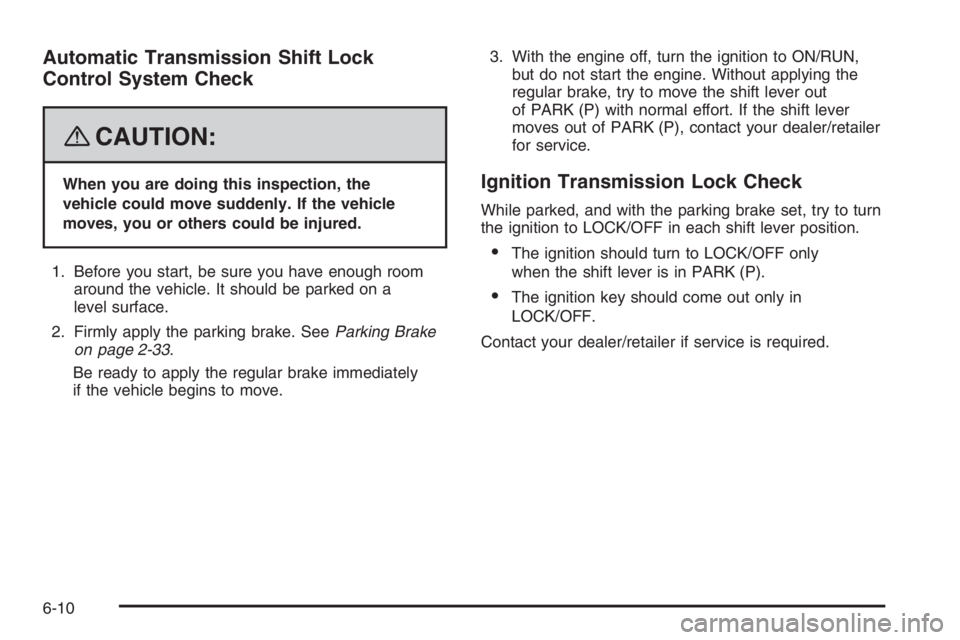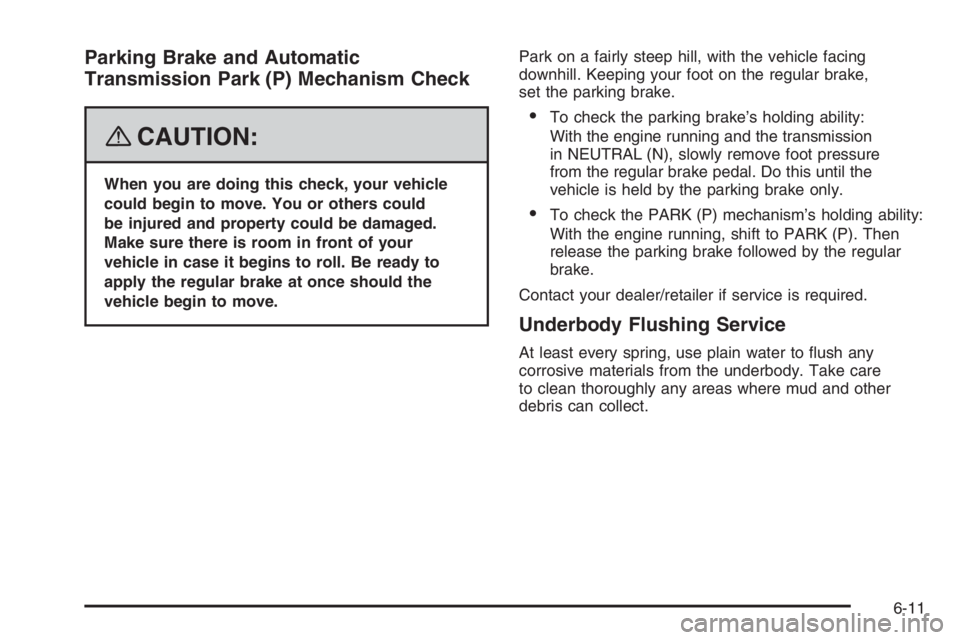2008 PONTIAC GRAND PRIX parking brake
[x] Cancel search: parking brakePage 407 of 450

Maintenance Footnotes
†The U.S. Environmental Protection Agency or the
California Air Resources Board has determined that the
failure to perform this maintenance item will not nullify
the emission warranty or limit recall liability prior to
the completion of the vehicle’s useful life. We, however,
urge that all recommended maintenance services be
performed at the indicated intervals and the
maintenance be recorded.
(a)Visually inspect brake lines and hoses for proper
hook-up, binding, leaks, cracks, chafing, etc. Inspect
disc brake pads for wear and rotors for surface
condition. Inspect other brake parts, including calipers,
parking brake, etc.
(b)Visually inspect front and rear suspension and
steering system for damaged, loose, or missing parts or
signs of wear. Inspect power steering lines and hoses
for proper hook-up, binding, leaks, cracks, chafing, etc.
(c)Visually inspect hoses and have them replaced if they
are cracked, swollen, or deteriorated. Inspect all pipes,
fittings, and clamps; replace with genuine parts as
needed. To help ensure proper operation, a pressure
test of the cooling system and pressure cap and cleaning
the outside of the radiator and air conditioning condenser
is recommended at least once a year.(d)Inspect wiper blades for wear, cracking, or
contamination. Clean the windshield and wiper blades,
if contaminated. Replace wiper blades that are worn or
damaged. See Windshield Wiper Blade Replacement
on page 5-61andWindshield and Wiper Blades on
page 5-116for more information.
(e)Make sure the safety belt reminder light and safety
belt assemblies are working properly. Look for any
other loose or damaged safety belt system parts. If you
see anything that might keep a safety belt system
from doing its job, have it repaired. Have any torn or
frayed safety belts replaced. Also see Checking
the Restraint Systems on page 1-66.
(f)Lubricate all key lock cylinders. Lubricate all hinges
and latches, including those for the body doors,
hood, secondary latch, pivots, spring anchor, release
pawl, rear compartment, glove box door, console
door, and any folding seat hardware. More frequent
lubrication may be required when exposed to a corrosive
environment. Applying silicone grease on weatherstrips
with a clean cloth will make them last longer, seal
better, and not stick or squeak.
(g)If you drive regularly under dusty conditions,
the filter may require replacement more often.
6-7
Page 409 of 450

Engine Coolant Level Check
Check the engine coolant level and add DEX-COOL®
coolant mixture if necessary. SeeEngine Coolant
on page 5-24.
Windshield Washer Fluid Level Check
Check the windshield washer �uid level in the windshield
washer �uid reservoir and add the proper �uid if
necessary.
At Least Once a Month
Tire In�ation Check
Inspect your vehicle’s tires and make sure they are
in�ated to the correct pressures. Do not forget to
check the spare tire. SeeInflation - Tire Pressure on
page 5-69. Check to make sure the spare tire is stored
securely. SeeChanging a Flat Tire on page 5-96.
Tire Wear Inspection
Tire rotation may be required for high mileage highway
drivers prior to the Engine Oil Life System service
noti�cation. Check the tires for wear and, if necessary,
rotate the tires. SeeTire Inspection and Rotation
on page 5-75.
At Least Once a Year
Starter Switch Check
{CAUTION:
When you are doing this inspection, the
vehicle could move suddenly. If the vehicle
moves, you or others could be injured.
1. Before you start, be sure you have enough room
around the vehicle.
2. Firmly apply both the parking brake and the regular
brake. SeeParking Brake on page 2-33.
Do not use the accelerator pedal, and be ready to
turn off the engine immediately if it starts.
3. Try to start the engine in each gear. The vehicle
should start only in PARK (P) or NEUTRAL (N).
If the vehicle starts in any other position, contact
your dealer/retailer for service.
6-9
Page 410 of 450

Automatic Transmission Shift Lock
Control System Check
{CAUTION:
When you are doing this inspection, the
vehicle could move suddenly. If the vehicle
moves, you or others could be injured.
1. Before you start, be sure you have enough room
around the vehicle. It should be parked on a
level surface.
2. Firmly apply the parking brake. SeeParking Brake
on page 2-33.
Be ready to apply the regular brake immediately
if the vehicle begins to move.3. With the engine off, turn the ignition to ON/RUN,
but do not start the engine. Without applying the
regular brake, try to move the shift lever out
of PARK (P) with normal effort. If the shift lever
moves out of PARK (P), contact your dealer/retailer
for service.Ignition Transmission Lock Check
While parked, and with the parking brake set, try to turn
the ignition to LOCK/OFF in each shift lever position.
The ignition should turn to LOCK/OFF only
when the shift lever is in PARK (P).
The ignition key should come out only in
LOCK/OFF.
Contact your dealer/retailer if service is required.
6-10
Page 411 of 450

Parking Brake and Automatic
Transmission Park (P) Mechanism Check
{CAUTION:
When you are doing this check, your vehicle
could begin to move. You or others could
be injured and property could be damaged.
Make sure there is room in front of your
vehicle in case it begins to roll. Be ready to
apply the regular brake at once should the
vehicle begin to move.Park on a fairly steep hill, with the vehicle facing
downhill. Keeping your foot on the regular brake,
set the parking brake.
To check the parking brake’s holding ability:
With the engine running and the transmission
in NEUTRAL (N), slowly remove foot pressure
from the regular brake pedal. Do this until the
vehicle is held by the parking brake only.
To check the PARK (P) mechanism’s holding ability:
With the engine running, shift to PARK (P). Then
release the parking brake followed by the regular
brake.
Contact your dealer/retailer if service is required.
Underbody Flushing Service
At least every spring, use plain water to �ush any
corrosive materials from the underbody. Take care
to clean thoroughly any areas where mud and other
debris can collect.
6-11
Page 438 of 450

Audio System (cont.)
Theft-Deterrent Feature...............................3-115
XM™ Satellite Radio Antenna System...........3-118
Audio System(s).............................................3-95
Automatic Transmission
Fluid..........................................................5-22
Operation...................................................2-28
B
Backglass Antenna........................................3-117
Battery..........................................................5-45
Electric Power Management..........................3-22
Exterior Lighting Battery Saver......................3-19
Run-Down Protection...................................3-22
Brake
Emergencies................................................ 4-5
Brakes..........................................................5-41
System Warning Light..................................3-45
Braking........................................................... 4-3
Braking in Emergencies..................................... 4-5
Break-In, New Vehicle.....................................2-23
Bulb Replacement...........................................5-54
Back-Up Lamps...........................................5-59
Front Turn Signal, Parking and Fog Lamps.....5-57
Halogen Bulbs............................................5-54
Headlamp Aiming........................................5-51Bulb Replacement (cont.)
License Plate Lamps....................................5-60
Replacement Bulbs......................................5-60
Taillamps, Turn Signal, and Stoplamps............5-58
Buying New Tires...........................................5-78
C
Calibration.....................................................3-65
California Fuel.................................................. 5-6
California Perchlorate Materials Requirements....... 5-4
California Proposition 65 Warning....................... 5-3
Canadian Owners................................................ ii
Capacities and Speci�cations..........................5-128
Carbon Monoxide...................2-14, 2-36, 4-17, 4-29
Care of
Safety Belts..............................................5-114
CD, MP3 .....................................................3-109
Center Console Storage Area...........................2-44
Chains, Tire...................................................5-84
Check
Engine Light...............................................3-50
Checking Things Under the Hood......................5-10
Chemical Paint Spotting.................................5-118
Child Restraints
Child Restraint Systems...............................1-35
Infants and Young Children...........................1-32
2
Page 446 of 450

P
Paint, Damage..............................................5-117
Park Brake....................................................2-33
Park (P)
Shifting Into................................................2-34
Shifting Out of............................................2-35
Parking
Over Things That Burn.................................2-36
Passenger Airbag Status Indicator.....................3-43
Passenger Compartment Air Filter.....................3-36
Passenger Sensing System..............................1-60
Passing.........................................................4-12
PASS-KEY
®III Electronic Immobilizer................2-20
PASS-KEY®III Operation.................................2-21
Perchlorate Materials Requirements, California...... 5-4
Power
Door Locks.................................................2-11
Electrical System.......................................5-121
Lumbar Controls........................................... 1-4
Retained Accessory (RAP)............................2-24
Seat ............................................................ 1-3
Steering Fluid.............................................5-39
Windows....................................................2-17
Pressure Cap.................................................5-27
Privacy..........................................................7-16
Event Data Recorders..................................7-16
Navigation System.......................................7-17Privacy (cont.)
OnStar.......................................................7-17
Radio Frequency Identi�cation.......................7-17
Programmable Automatic Door Locks.................2-12
R
Radio Frequency Identi�cation (RFID),
Privacy......................................................7-17
Radio(s)........................................................3-95
Radios
Reception.................................................3-116
Setting the Clock.........................................3-95
Theft-Deterrent..........................................3-115
Rear Assist Handle Reading Lamps...................3-21
Rear Door Security Locks................................2-12
Rearview Mirror with OnStar
®...........................2-38
Rearview Mirrors.............................................2-38
Reclining Seatbacks.......................................... 1-5
Recommended Fluids and Lubricants.................6-12
Recreational Vehicle Towing.............................4-27
Remote Keyless Entry (RKE) System.................. 2-3
Remote Keyless Entry (RKE) System,
Operation..................................................... 2-4
Remote Vehicle Start........................................ 2-7
Removing the Flat Tire and Installing
the Spare Tire...........................................5-100
10